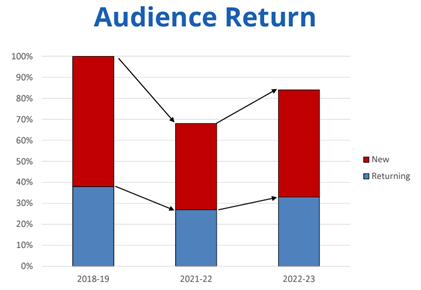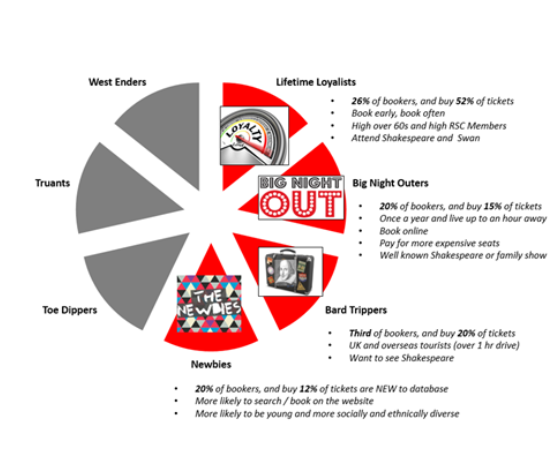Data in Marketing: Audience Retention

Jamie Alexander
Director, JCA Arts Marketing
Audience retention has been a hot topic in our field as subscription sales decline and we rebuild audiences after COVID. We all know the importance of getting a new audience member to come back for a second time, but how do we also make sure that they feel like part of our community, beyond just the return invite?
Finding the right messaging and offers to bring new audience members into your community is an art as well as a science. The journey starts with collecting data on new audience members, which then funnels them into an audience segment, which informs you how to communicate with them.
In this article, we’ll focus on first-time audience member retention due to our recent study, where we found that new audiences consistently make up a higher percentage of audiences across the industry. Additionally, new audiences have grown since the reopening 2021-22 season:

Though we’re focusing on first-time audience members in this blog post, the sequence of collecting data, segmenting, and communicating applies to any audience member.
Audience Retention Step 1: Collect Data
The first step to engage new audience members is to collect data regarding their interaction with your organization. Collect data such as:
- What program did they attend?
- When did they buy their tickets?
- How many tickets did they buy?
- How much did they pay for their tickets?
- What type of ticket did they purchase? Full-price, discount, etc.
- What marketing materials did they engage with before purchase?
- How was their experience of the show?
This data will help you to 1) understand new audience member behavior and characteristics, in order to effectively target other potential new audience members in future campaigns and to 2) segment new audience members in order to send them targeted and personalized offers.
Audience Retention Step 2: Segment
Once you’ve collected the data on your new audience members, you should use that data to classify them into one of your existing audience segmentations. Audience segmentations allow you to message your audience with personally tailored messages that inspire action. Here’s an example of an audience segmentation that we love from the Royal Shakespeare Company:

Your existing audience segmentation might also inform what data is essential for you to collect in Step 1, so that you have the data needed to categorize each patron into a segment.
Audience Retention Step 3: Communicate
The segment you assign to your new audience member will inform the return invitation you include in their post-show email—in terms of timing, message, and offer. However, it’s important that the use of segmentation extends beyond the initial re-engagement to their integration as an engaged member of the community. Following the invitation to return, the new audience member can then be included in communications to that segment moving forward.
Audience segmentation allows for an additional layer of personalization, beyond offers, that will make your communication compelling for continued engagement with your organization. Using the example in Step 2, if your new audience member were added to the Big Night Outers segment, you might include messaging about special supplementary events to make their big night out even more special. Additional touchpoints for engagement based on segmentation insights will result in a rewarding relationship for both the audience member and organization.
For more information about how to tailor communications to segments, which will make your marketing communications much more efficient, check out our blog post on the Segmentation Playbook.
We’re Here to Help!
If you need help collecting data on audience members, creating an audience segmentation, or designing a plan to communicate with audience segments—this is our specialty. We can help you organize your data, strategy, and processes to reach your goals.

